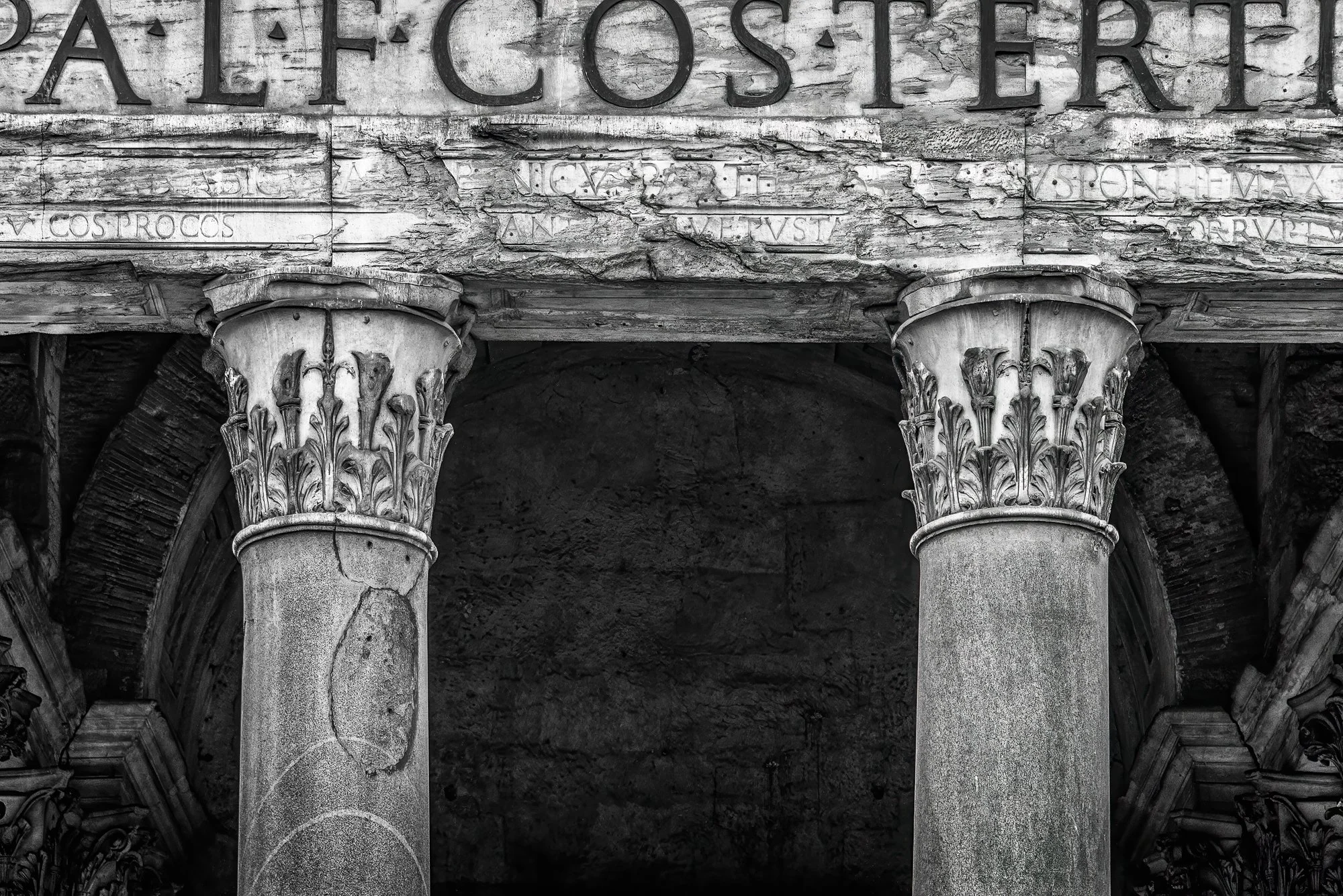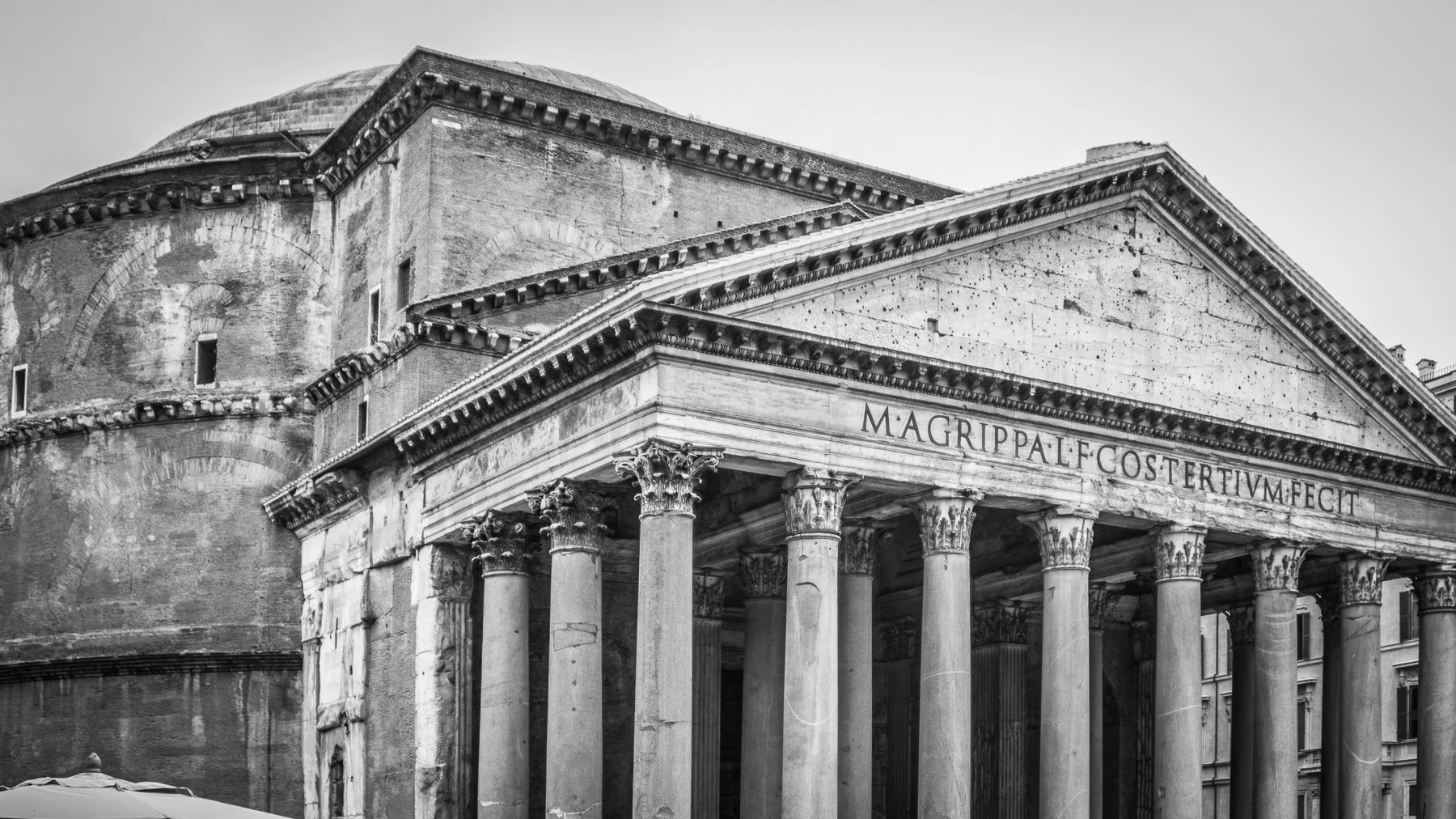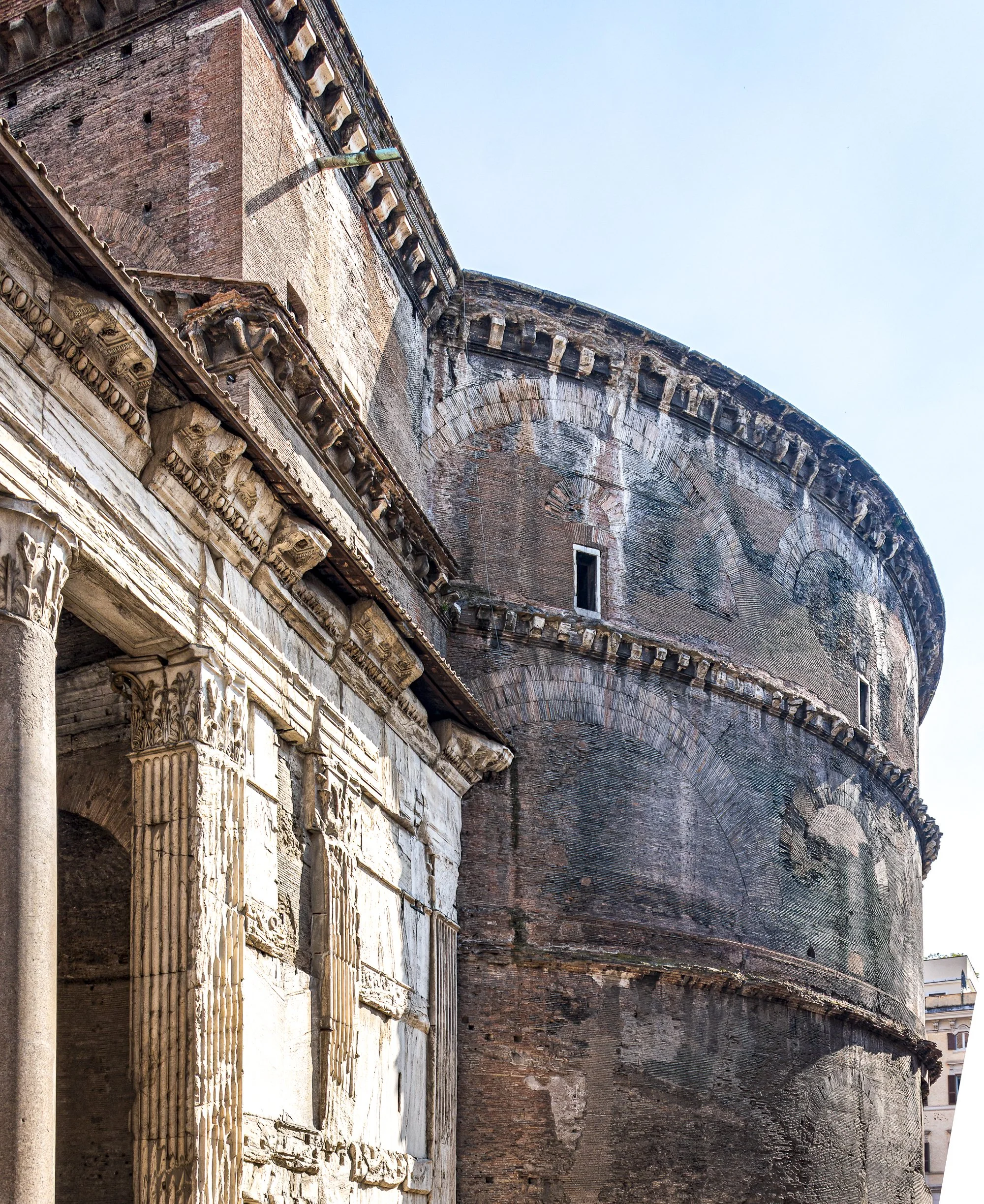Two of Rome’s finest
In Part 1 of our Central Rome Walking Tour, we saw two beautiful smiling police women as we began. It only seems fair that we start today’s walk with a couple of hansom smiling police men. I do love to photograph and honor those who protect us, wherever we may be.
We are back in Rome and we’ve been walking. We are just about to leave the beautiful Trevi Fountain. But, before we do, let’s make sure that we did all that one should do there.
TREVI FOUNTAIN CHECKLIST
Toss coins into the fountain…not only is it allowed, it’s encouraged! Every Monday and Friday morning, the fountain seating area opens later to allow for the collection of coins tossed by us visitors.
Group Photo
Take group selfie
Ask someone to take your photo for you instead *
Look at those around you for interesting photo opportunities; like the beautiful police women that headlined the Part 1 article, or the guy in the window.
Take panoramic fountain photo from 2nd Floor of the United Colors of Benneton
Fun Photo Tip: When someone asks you to take a group photo of them with their cellphone, as you get the camera lined up, and without announcing what you are doing, press the ‘selfie’ button and capture a selfie of yourself…and then tap that button again to unselfieize the camera and then snap away at the group. Making a face during your selfie is optional, but fun. I’ve done this a dozen times and I think that I’m hilarious.
What Not to Do at the Trevi Fountain
Beginning in 2025, there are some new rules at the Trevi. These rules apply to being in the managed area front-and-center of the fountain. I considered going through those rules, but unless you are actually in the process of going to Rome, you would be wasting your time reading through them. And, we need to get to our walk, don’t we? But, if you are planning a Rome trip, go HERE to check out the latest rules. Rule #1: No swimming in the Trevi1!!
CONTINUING OUR CENTRAL ROME WALKING TOUR
Trevi Fountain to Column of Marcus Aurelius
We have just a very short walk to get to the next stop. That stop is an unbelievable (yet, I do believe it because I’ve seen it!) carved stone column that celebrates Marcus Aurelius. Along the way to this beautiful column, we will have a chance to do a bit of light shopping…remember that you don’t want to be shlepping around heavy shopping bags on our walk.
Here is a map of our walk, which is only about 2 blocks. We start in the bottom-right corner of the map and we walk to the left side of the map.
Galleria Alberto Sordi
The outside of this galleria belies the beauty of the inside. I would suggest a stroll through the galleria, whether you want/like to shop, or not. This Italian galleria is a covered shopping arcade featuring a glass roof and it is lined with shops and restaurants. By now, you may be ready for a snack, do you think? At any rate, it does no harm to walk through, and then you can say that you did it. To see what you will see when you see it, see HERE.
THE COLUMN OF MARCUS AURELIUS
The Column of Marcus Aurelius is a Roman ‘victory column’. The victory refers to his success in the Barbarian Wars. Way to go, Marcus! No one likes barbarians, right? The column was started shortly after his death in the year 180AD. So, this column was not carved recently, and it did not involve a bit of AI and modern powered tools. It was erected in the year 193AD!!! Yes, that’s over 1,800 years ago. And who was Marcus Aurelius? I’ll not bore you with that…you know how to search for that information. I’ll just say that at the age of 40, he became Roman emperor on 8 March 161.
Let’s take a look at this unique column…we will start with a distant view and work our way into the marvelous detail.
Distant view of the Column of Marcus Aurelius
You will note in this next photo with a bit of detail that the frieze spirals up the column. I’ll give you a fact with each photo. The first fact was that the carving spirals up the column.
The next fact is that there are 21 spirals in total that slink their way up the column. And by the way, the column is 97 feet tall, and that cubic base is 33 feet tall. That adds up to 130 feet in height.
The 21 spiraling motifs of the Column of Marcus Aurelius
The next fact is that those 21 spirals make up an unbelievable total of 367 feet of detailed carvings if you were to unslink them into one long piece. Can you tell that the diameter of the Carrera marble column is 12 feet?
Is it solid marble? The next fact left me stammering…
Detail of the Column of Marcus Aurelius
And here is your next friarzsct (sorry, I was trying to type ‘fact’, but I was still stammering): The inside is hollow, and there are over 190 steps to the top platform! In the photo just above, you can see an opening slit in the column about 1/4 way from the top, and another about 1/3 up from the bottom…both on the left 1/3 of the column. Those slits provide sunlight inside for your trek up the stairs.
It’s absolutely insane the way that it got carved. Once again…no modern stone carving instruments!!! Just look at the detail below. People. Animals. Vegetation. Spears and swords. Shields. Cloth and clothing. The people even have facial expressions!
Another amazing thing is that it has survived these 1,800 years with little deterioration.
Detailed view of the Column of Marcus Aurelius
I hope you enjoyed our viewing of the ancient Column of Marcus Aurelius. I’ve stopped stammering, though I am now staggering a bit as we head to our next stop because I’ve been staring straight up for the past 15 minutes and I can’t seem to point my head down to see ahead.
On to the Pantheon
We have just a short walk to our next destination, which is the ancient Pantheon. We start at the corner of the Piazza Colonna (where the Column of Marcus Aurelius is located) that is furthest from the Galleria Alberto Sordi. This takes us immediately to the Piazza di Monte Citorio. The large building to our right as we begin our walk is the Chamber of Deputies meeting place for Italy's parliament.
As you begin to head away from that building, you will see an obelisk in the piazza. After having seen the wonderful Column of Marcus Aurelius, its ok to be disappointed as you pass the obelisk. Twist and turn your way to Via in Aquira to Piazza Capranica and then twist and turn a bit more on Via degli Arfani until you are at the large pizza on which the Pantheon sits…(sorry spell check didn’t capture that mistake)…it should have said that the Pantheon sits on a large piazza.
THE PANTHEON
The Pantheon, like much of Rome, is ancient. It was built about 126AD as a temple of all the gods. Think ‘pan theology’. Just below you see the front face of the Pantheon in a photo that I took in 2012.
The front of the Pantheon with surrounding distractions removed
You need to know what the words across the front of the Pantheon represent. It means that Marcus Agrippa, son of Lucius, built this when he was consul for the third time.
I put the words into my Google Translate app and came up with something different and weird because I made to small errors when I typed it in. I typed ‘MAGRIPPA L F COSTERTIVM FECIT”…i.e. I didn’t have a space between the M and A at the beginning, and I didn’t have a space between the S and T as required. You can check this out for yourself by translating just as I have typed it…it translates to “The flu made him sick”. Seriously? Now, it would be really spooky if Marcus Agrippa had died of the flu.
There are 16 large granite Corinthian columns (eight in the first rank and two groups of four behind) under a pediment. As you get close to the entrance to the portico and pass by the first row of columns you get an idea of just how ancient this building is.
Once inside, the beauty of the interior stands out. Though the building started out as that tribute to all the gods, since AD 609, it has been a Catholic church called the Basilica of St. Mary and the Martyrs. God has been glorified by the beautiful additions of the church, as seen below.
The interior is an architectural wonder of geometry. A sphere with a diameter of 142 feet can fit perfectly snug inside.
This means that the open top, called an oculus, is 142 feet above the floor.
The oculus of the Pantheon rotunda as photographed by Victor Grigas
Here you see a fisheye lens view taken straight up by Victor Grigas. I added a red circle to designate the opening of the oculus. A faint sun beam can be seen projected through the oculus like an hour hand pointed at 4 o’clock.
Here are a couple more exterior photos that I captured so you can see again the ancient time-worn patina of the Pantheon.
That large piazza in front of the Pantheon is quite nice. It’s called the Piazza della Rotonda. There is a fountain commissioned by Pope Gregory XIII that has a combination of ornate marble dolphins and an obelisk.
The Piazza della Rotonda
Let’s take a closer look at that fountain. I’ll cut it out and remove the young lady photographer.
There are some crazy looking creatures embellishing this fountain. The sculptor must have had some early childhood nightmare issues.
Just below the central shield you see the letters “SPQR”. This is seen all over Rome and is an acronym for “The Senate and People of Rome”. The wording just under says that it was restored in 1880. Nice job.
The Fontana del Pantheon
Water fountain in the Piazza Rotunda
And right in front of the fountain, but not visible in the photos above, is this drinking fountain. It runs continuously.
What about that potential waste of water? Remember in Part 1 that the Trevi Fountain is fed by the Virgo Aqueduct, completed a few years ago in 19 BC by Marcus Agrippa. The source of this drinking fountain’s water here near the Pantheon is probably that aqueduct.
Once again, we see the initials “SPQR” on this object.
I do believe that this is enough for today. We will end our Central Rome Walking Tour in Part 3 next time by visiting a wonderful piazza and a campo (a campo is not large enough to be considered a piazza, but that designataion is not a measure of its significance).
I may take a quick trip to Rome this week to get a closer look at those fascinating fountain creatures! But, I’ll be back in time for the next installment of my Italy, Our Italy article on our Central Rome Walking Tour. Until then, I say ‘ciao for now’ and ‘Diem tibi benedictus spero!’
Steve




